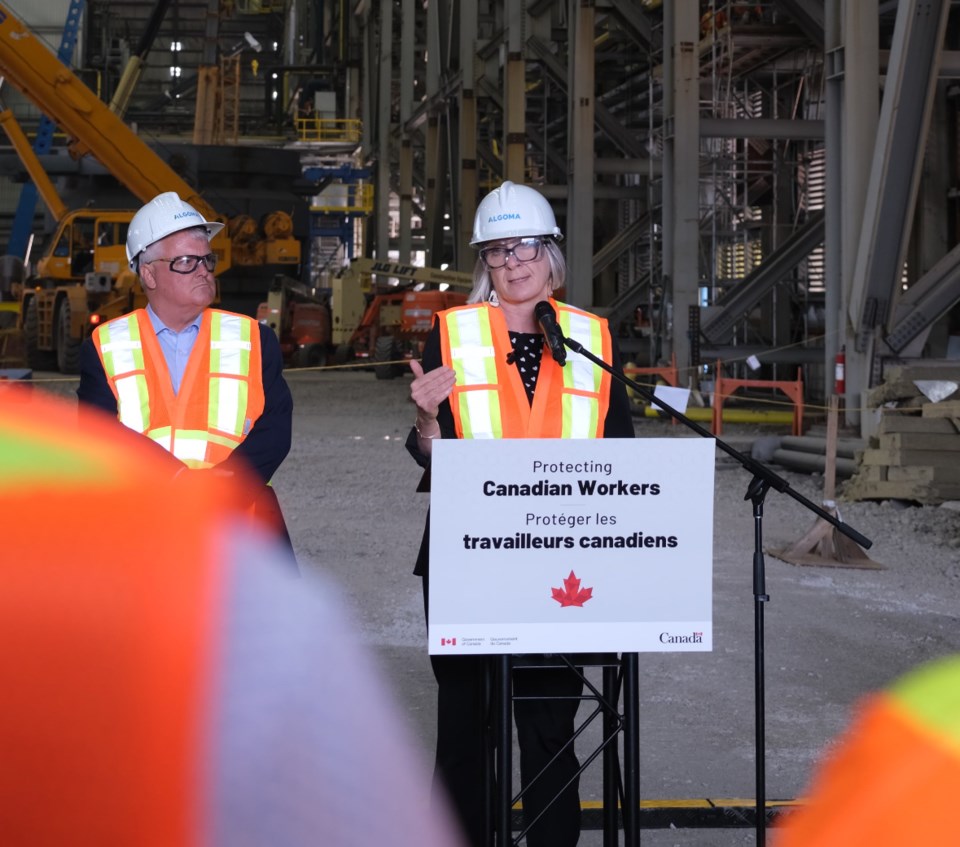SAULT STE. MARIE — “Through Bill C-5, we're hoping to be able to very quickly get large national projects of interest off the ground,” said Thunder Bay—Superior North MP Patty Hajdu. “Many of those projects will require steel, and we will make it a condition that Canadian steel and other products are prioritized.”
As minister of jobs and economic affairs, Hajdu was at Algoma Steel in Sault Ste. Marie Wednesday, talking about a suite of targeted measures announced by Prime Minister Mark Carney, aimed at protecting and strengthening Canada’s steel industry, including more than $1 billion in funding to support the industry.
Among the key actions announced is a plan to increase tariffs on non-free trade agreement partners to 50% of 2024 volumes. Hajdu described the move as a direct response to steel dumping and competition from countries like China and Russia, noting that a 25% tariff will soon apply to any steel imports containing material melted and poured in China.
In addition, for countries with which Canada has a free trade agreement (excluding the U.S. and Mexico), imports will be capped at 100% of 2024 volumes, with a 50% tariff applied to amounts above that threshold. Trade terms under CUSMA remain unchanged.
She noted that this aligns with rising interest from the defence sector in sourcing more materials domestically. “I've already seen some comments from some of the stakeholders that, at a recent defence procurement conference, steel companies were heavily visited by defence procurement agencies to talk about procuring Canadian steel.”
To support workers affected by changing market conditions, Ottawa is also investing $70 million into Labour Market Development Agreements (LMDAs). According to Hajdu, this funding will provide training and income support for up to 10,000 steelworkers across the country, "not just in Ontario, but in other provinces with steel operations" she said.
The funding will help workers retrain or upgrade their skills to meet evolving demands, especially as producers pivot to serve new markets with different product requirements. It will also support workers who may be displaced, helping them transition quickly into new roles using their existing expertise.
Additional funding measures include $1 billion through the Strategic Innovation Fund to help producers modernize facilities, expand domestic capacity, and diversify product lines. A $150 million Regional Tariff Response Initiative will provide localized support through regional development agencies.
For small and medium-sized steel firms, the Business Development Bank of Canada's Pivot to Grow initiative will be expanded to assist those facing liquidity challenges.
Large steel companies will also benefit from updates to the Large Enterprise Tariff Loan program, which will now include lower thresholds for eligibility, reduced minimum loan sizes, extended loan maturities, and lower interest rates, provided firms commit to worker retention.
Hajdu clarified that the new measures are specific to the steel industry and are not directly tied to other Northwestern Ontario resource projects, such as the Ring of Fire.
“This is specifically for steel,” she said. “If there are other shocks to other mineral sectors, Canada will respond sector by sector.”
“In terms of the Ring of Fire, that is a development that is not necessarily deeply impacted by tariffs on steel, at least not yet.”
That said, Hajdu confirmed that the federal government is actively reviewing employment insurance and skills training programs to ensure they are responsive to rapid global economic shifts and trade changes.
